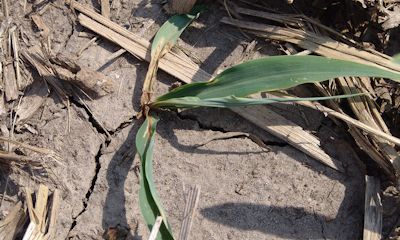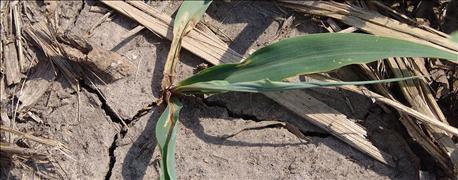May 1, 2016

Wet field conditions from recent rainfall events across Nebraska may put early planted corn at added risk for seedling diseases. Cool soil temperatures and episodes of recent rainfall are especially favorable for some of the most common and damaging seedling diseases. Be sure to monitor seedling emergence and stand establishment in the coming weeks so that if problems occur they can be detected as early as possible.

Figure 1. Corn seedling with post-emergence damping off.
Seedling diseases to watch for
Seedling diseases can be caused by any of several common soilborne organisms, such as Pythium, Fusarium, Rhizoctonia or plant parasitic nematodes. Seedling diseases are often difficult to diagnose because their symptoms are very similar. Sometimes, diagnosis may be of limited value because management is often the same for several seedling diseases. Microscopic examination and other laboratory analyses of the diseased seedlings can often identify the cause(s) of the problems. Seedling diseases can be confused with insect injury, herbicide damage, planting problems, or environmental stresses that often have similar symptoms.
Seedling disease symptoms include:
• Rotted seed prior to germination
• Rotted or discolored seedlings after germination prior to emergence
• Post-emergence seedling damping off (Figure 1)
• Root or hypocotyl decay
Managing corn seedling diseases
Unfortunately, resistance is not available for seedling diseases in corn. Improved field drainage can help reduce the incidence and severity of some seedling diseases, as well as delaying planting until soil conditions are warmer and will promote rapid seed germination and emergence. The most common method for disease management is seed treatment fungicides now applied to almost all seed corn.
Crop rotation can reduce seedling diseases to some extent; however, some of these diseases may also infect soybean and other crops.
Most seed corn is already treated with more than one seed treatment fungicide, often an insecticide, and, sometimes a nematicide. These products can provide protection against some of the pathogens that cause seedling diseases. In spite of their activity, diseases may still develop, such as during extended periods of inclement weather or under severe pathogen pressure.
Seed treatment fungicides will only provide protection during the first few weeks immediately after planting. Growers can minimize the likelihood of developing seedling diseases by planting high quality seed at appropriate planting depths and soil conditions to support rapid plant growth and emergence.
For additional information, contact Tamra Jackson-Ziems, University of Nebraska Extension plant pathologist at [email protected], or visit cropwatch.unl.edu.
Source: UNL CropWatch
You May Also Like




